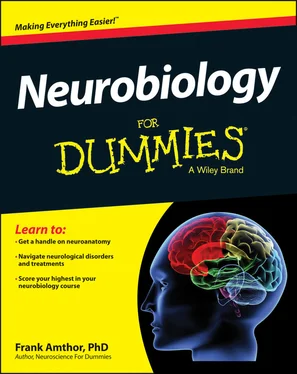Post-translational processing
When proteins are created by ribosomes that translate the mRNA into polypeptide chains, the amino acid polypeptide chains may undergo folding and/or cutting before becoming the final protein. The processes of folding and cutting often occur in the endoplasmic reticulum and may include structural changes based on the formation of disulfide bridges.
Also after translation happens, other biochemical functional groups may be attached to the amino acid sequence of the protein, such as carbohydrates, lipids, and phosphates. Adding phosphate groups is called phosphorylation. This is a common mechanism for activating or inactivating an enzyme protein.
Some of the amino acids on a polypeptide can be modified. For example, the amino acid arginine can enzymatically converted to citrulline in a process called citrullination . The presence of citrulline residues can alter the protein’s structure and thereby change its function. Vesicles containing secretory proteins and some neurotransmitters then pass through the Golgi apparatus, where additional post-translational modifications can occur.
Various enzymes may cut the peptide chain or remove amino acids from the amino end of the protein. Also, most polypeptides initially start with the amino acid methionine because the “start” codon on mRNA codes for it. Methionine is usually taken off during post-translational modification.
Epigenetics is the change in gene expression (and thus, cell phenotype, which we discuss earlier in this chapter) due to mechanisms other than changes in the underlying DNA sequence. The most important epigenetic mechanisms are DNA methylation and histone modification. Other mechanisms include X chromosome inactivation, transvection, and paramutation. Teratogens (environmental agents that cause cancer) often act through epigenetic mechanisms.
Epigenetic changes may persist through all cell divisions of a cell and be passed to offspring. If this sounds “Lamarckian” to you, you’re partly right. In the original development of the theory of evolution, an alternative theory advanced by French biologist Jean-Baptiste Lamarck was that acquired characteristics could be inherited. Giraffes, for example, by stretching their necks to reach leaves on higher branches would give birth to offspring with longer necks.
 However, we know that Lamarck’s hypothesis is not the main way that evolution works. An important difference exists between epigenetic and Lamarckian inheritance. The Lamarck hypothesis offers no specific mechanism by which a trait acquired or developed through practice can be inherited. In epigenetics, however, the change in DNA expression may or may not be linked to any behavior, and may or may not actually be selected for in terms of that behavior. Epigenetic changes work according to standard Darwinian evolution.
However, we know that Lamarck’s hypothesis is not the main way that evolution works. An important difference exists between epigenetic and Lamarckian inheritance. The Lamarck hypothesis offers no specific mechanism by which a trait acquired or developed through practice can be inherited. In epigenetics, however, the change in DNA expression may or may not be linked to any behavior, and may or may not actually be selected for in terms of that behavior. Epigenetic changes work according to standard Darwinian evolution.
Epigenetic changes are crucial in the process of cellular differentiation during development, where totipotent stem cells (cells that can develop into any cell type) differentiate into hundreds of different cell types such as neurons, muscle cells, or liver cells. This happens because of epigenetic activation and inhibition of relevant genes preserved in subsequent cell divisions of that cell line.
Meeting Cell Molecules: Important Ions and Proteins
What distinguishes neurons from other cells in the body is that they are excellent communicators. Their membranes contain receptors and ion channels that allow them to do the following:
Sense energy and substances from the environment
Communicate between distant parts of the same cell
Communicate with other neurons
Activate muscles and secretory cells
Most cells in the body have the DNA required to produce the hundreds of ion channel and receptor proteins found in neurons. But the genes that code for many of these neuronal proteins are expressed only in specific types of neurons, and not other cells. Many neuron-specific proteins form receptors or ion channels that either directly or indirectly control the flow of four major ions through the membrane: sodium, potassium, chloride, and calcium. The next section explores these ions in more detail.
The most important ions that flow through neuronal membrane channels are sodium, potassium, chloride, and calcium. A fifth ion, magnesium, is also important because it controls conduction through the NMDA receptor, a glutamate receptor. The following list tells you more about the roles of these ions inside neurons:
Sodium: The concentration of sodium is much higher outside the cell than inside the cell. Sodium entering into cells can trigger action potentials and lead to synaptic release, two crucial neural functions.
Potassium: This ion has a high concentration inside cells compared to fluid outside cells. So, opening potassium channels tends to hyperpolarize cells (make the inside more negative) by the exit of the positively charged potassium ions.
Chloride: The concentration of chloride is low inside the cell compared to the outside. Although the tendency exists for diffusion to dissipate this concentration gradient, chloride ions feel a repulsive force from the negative membrane potential inside the cell. Chloride flux tends to occur mostly when the cell is depolarized by an excitatory event. Chloride currents are usually inhibitory.
Calcium: This ion is found in very low (nanomolar to micromolar) concentrations inside neurons because it is heavily buffered by calcium chelating (binding) molecules. Calcium can enter cells through calcium-specific channels and some neurotransmitter channels such as NMDA glutamate receptors and alpha-7 nicotinic acetylcholine receptors. Calcium modulates second messenger cascades inside cells that regulate ion channels from the inside, and may also affect gene expression. The flux of calcium through voltage-dependent calcium channels results in the release of neurotransmitters from axon (the part of the neuron that conducts impulses away from the cell) terminals.
Magnesium: Normally magnesium does not pass through neuronal membranes. However, when the neuron is close to the resting potential, magnesium, attracted to the negative charge inside, binds in the extracellular “mouth” of the NMDA glutamate receptor. This receptor will not open unless, in addition to binding glutamate released from a pre-synaptic axon terminal, the membrane is partially depolarized. This depolarization (which is often provided by nearby non-NMDA excitatory receptors) reduces the potential across the membrane and thereby favors the release of the magnesium ion, allowing sodium and some calcium to flow through the channel.
Membrane ion channels and receptors are typically composed of several proteins called subunits that, when assembled in the membrane, form a receptor or ion channel. At least 1,000 different receptor types exist in the olfactory (smell) system alone, each with a different combination of protein subunits with varying structures. The majority of ion channels and receptors have from four to six protein subunits.
Going through membrane proteins
Membrane proteins have a three-dimensional configuration. One end of the protein is either in the intracellular or extracellular fluid, the transmembrane region resides within the phospholipid membrane, and the protein terminal, like the beginning, is either in the intracellular or extracellular fluid. Most membrane protein subunits make multiple loops that are embedded in the membrane.
Читать дальше

 However, we know that Lamarck’s hypothesis is not the main way that evolution works. An important difference exists between epigenetic and Lamarckian inheritance. The Lamarck hypothesis offers no specific mechanism by which a trait acquired or developed through practice can be inherited. In epigenetics, however, the change in DNA expression may or may not be linked to any behavior, and may or may not actually be selected for in terms of that behavior. Epigenetic changes work according to standard Darwinian evolution.
However, we know that Lamarck’s hypothesis is not the main way that evolution works. An important difference exists between epigenetic and Lamarckian inheritance. The Lamarck hypothesis offers no specific mechanism by which a trait acquired or developed through practice can be inherited. In epigenetics, however, the change in DNA expression may or may not be linked to any behavior, and may or may not actually be selected for in terms of that behavior. Epigenetic changes work according to standard Darwinian evolution.










